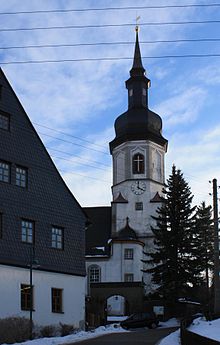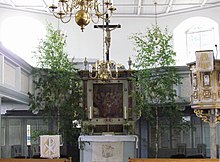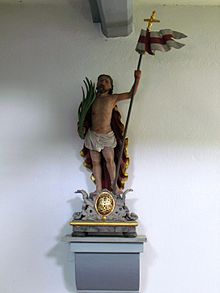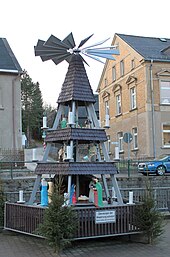Bockau
| coat of arms | Germany map | |
|---|---|---|
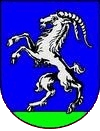
|
Coordinates: 50 ° 33 ' N , 12 ° 41' E |
|
| Basic data | ||
| State : | Saxony | |
| County : | Erzgebirgskreis | |
| Management Community : | Zschorlau | |
| Height : | 500 m above sea level NHN | |
| Area : | 19.15 km 2 | |
| Residents: | 2225 (Dec. 31, 2019) | |
| Population density : | 116 inhabitants per km 2 | |
| Postal code : | 08324 | |
| Area code : | 03771 | |
| License plate : | ERZ, ANA, ASZ, AU, MAB, MEK, STL, SZB, ZP | |
| Community key : | 14 5 21 080 | |
| LOCODE : | DE 2B4 | |
| Association administration address: | August-Bebel-Str. 78 08321 Zschorlau |
|
| Website : | ||
| Mayor : | Siegfried Baumann (independent) | |
| Location of the municipality of Bockau in the Erzgebirge district | ||
Bockau , called "Bucke" in the local dialect , is a municipality in the Erzgebirge in Saxony . The place is known as a herbal and laboratory technician place and bears the popular nickname Laborantendorf des Erzgebirge . Due to the centuries-long and first cultivation in the Ore Mountains of Angelika , whose roots are used in the manufacture of medicines and liqueurs, Bockau is also called "de Wurzelbucke" in the immediate vicinity.
Location and neighboring communities
The place is located in the western Ore Mountains in a protected valley basin in a side valley of the Zwickauer Mulde , which extends up to the Ochsenkopf near Jägerhaus .
Neighboring towns and communities in Bockau are: Aue-Bad Schlema , Lauter-Bernsbach , Schwarzenberg / Erzgeb. , Eibenstock and Zschorlau .
| Zschorlau | Aue-Bad Schlema | |

|
Lauter-Bernsbach | |
| Eibenstock | Schwarzenberg |
history
Origin of the place in the 13th century and the activities of its inhabitants
Numerous individual finds and excavation elements allow the conclusion that Bockau was created around 1200. It owes its name to the river Bockau, which occurs in various spellings such as Bockaw (1470), Puckaw (1495), Buckaw (1534), Pughawe (1541) or Bockaw (1579) in old documents and traced back to the Old Sorbian bukava ( beech water ) becomes. Another explanation of the name sees the Slavic word for beech bukowina as its origin. In the course of development, the ending wina probably became an au . The derivation from bukowy (for book) is also possible .
Fifteen full farmers initially settled here. In addition to agriculture, animal husbandry and forest use, free mining arose at the beginning of the 16th century. Lured by the great mountain cries of the Erzgebirge in the 16th century (finds and mining of silver, tin, cobalt, white earth and gravelly ore) numerous miners from the Harz found a new home here, so now mainly Zinnseifner settled in Bockau. They built simple houses that consisted of only one room and were called soap houses . Their number was given as 55 in 1568, and 85 houses were counted by 1612. Bockau got the status of a mountain patch , which was comparable to the status of a mountain town, only Bockau was not a town. The heyday of mining extended into the 19th century. Veins of cobalt-nickel-silver or tin in granite have been developed and exploited. Other mineral resources such as white earth , yellow earth or emery soon belonged to the mining products that were successfully sold in other German countries.
The Bockauers also received the right to boil pitch (1450), slaughter cattle, brew beer and fish in the village stream and in sections of the Mulde from the Saxon sovereign . They were also allowed to hunt small game . Important sideline sources for the farmers were logging, charcoal burning , Harz pasture and rafting .
The Thirty Years' War also claimed victims in Bockau. In 1632 Bockau was sacked by Holk's troops . In 1633 , 108 of the 500 inhabitants were killed by the plague . The Swedish troops also killed Bockauer in 1640 or plundered their residential huts.
Earthquake in 1770
In 1770, Bockau was also affected by an earthquake, which was even reported in a newspaper in Augsburg: It is reported from Leipzig that an earthquake in Bockau, Schneeberg, Johann Georgenstadt, Eybenstock and in the whole of the native region, but with special damage, been felt. George Koerner also describes the earthquake, which dragged on from the end of October to November with various tremors , so strong on November 4th that the floor was moved by stone floors and the barricade on it cracked with tremors, as then also the locks and iron bolts on the doors burst and shook; at 10 o'clock a little less than the sermon, but so that you could feel it in the window. The last time the earthquake was felt on November 20, 1770.
Upswing and end of the pharmaceutical industry
The intensive use of the forest led to the development of herb and root collectors and further processing using alcoholic or aqueous extracts or evaporation into medicinal extracts. Above all, bearwort , lovage , angelica , valerian and rhubarb were collected. From the essential oils of the plant parts, healing tinctures were created in various dosage forms. Last but not least, schnapps was made . From 1500 onwards, a kind of medicine laboratory technician developed. The newly established laboratories soon also processed raw materials from other areas and produced pills, ointments, balms, drops, powders and plasters. A list of residents from 1767 indicates that half of 120 people in employment produced or traded pharmaceuticals. Due to complaints from doctors and pharmacists, who viewed the herbalists as “unfair competitors”, production became more and more difficult, so that laboratory technicians finally came to a standstill in the 19th century. As recently as 1873, Meyers Handlexikon des Allgemeine Wissens referred to Bockau as the "main town of the Erzgebirge medicinal herb cultivation and earlier olive trade"
church
The first church already existed in 1529. During the first church visit in January / February of 1529, it was found that Bockau did not yet have its own pastor and belonged to Aue, but a church had already been built. Today's baroque church was consecrated on November 6, 1637 after a fundamental reconstruction of the church building from 1429. According to more recent findings, it was added to the existing smaller church space. The tower was built between 1719 and 1723. Dehio's Handbuch der Kunstdenkmäler rated the interior of the church in the Saxony II volume: “Charming hall with flat ceiling and surrounding galleries” . The altar from 1617 shows the coat of arms of Electoral Saxony on the cheeks, the architectural frame is adorned with angels' heads, a painting of the Last Supper is central. In “Saxony's Church Gallery”, Bockau's pastor Friedrich August Apfelstädt points out in 1842: “This altar contains a painting that is in any case the work of a great master who is not Lucas Cranach.” Forty years later, Richard Steche calls it “ artless ”. Two pewter candlesticks from around 1677 with the motif of miners are a reminder of the time when mining was also carried out in Bockau. The candlesticks are a gift from the climber Samuel Enderlein. The pulpit from 1658 with extensive carvings in the colors white, gold and blue is also adorned with angels' heads, in the fields of the parapet Christ, Moses and Evangelists are set as relief figures. A number of coffin shields, grave slabs and portraits in the vestibule from different epochs reveal parts of the church's history. A cast iron grave slab of the first Bockau pastor Ehrenfried Hain, who died in 1685, is described by Dehio as an “excellent” work.
Bockau has been an independent parish since 1678. The rectory from 1736 used to be a school, a groined vault is ascribed to the previous building from 1656.
In 1747 Magister George Körner became pastor in Bockau. He was a chronicler and linguist as well as the founder of the Bockauer Annual News series . His portrait hangs in the church. In 1768 the Musical Society or Cantorey was established "for the glory of God and glorification of public worship". George Körner lists the 13 founding members, all men, in his review of the chronicle.
Famine in 1771/1772
George Körner wrote about the famine in his book “Old and New from Bockau”, which was probably published at the beginning of 1772 - review no. 6 from 1772:
- The taxation still affects the country and especially us on the Bohemian frontier, where the supply has been blocked by a drawn military belt, in such a way that all trade and food are forfeited. The mine has closed again, with the exception of a new find for the St. Johannis treasure trove; the brown food has also subsided; the misgrowth came on top of that, with persistent rain for 6 weeks, and poverty had to abandon almost everything in clothing and furniture, and take refuge in herbs, berries, sponges and bran flour, because a bread of 6 pounds for 7, 8 and 2 halves Couldn't pay pennies, many of which died and many died.
Pastor George Körner died on May 3, 1772 in Bockau during the great famine. This caused the population to drop from 1,015 in 1756 to only 973 in 1772.
Mining and industry
In 1754 Christoph Gottlob Grundig describes Bockau as a "mountain spot":
- There is a moderately built church with a pastor. The associated school is small. … There are also beautiful mines here, from which silver, tin, Bley, Kupffer and Kobald are dug. The same white earth is found there, which is supplied in great quantity to the porcelain factory of Meisen. The majority of the population are miners ... He copied this almost verbatim in a travelogue published as early as 1735.
In his work published in 1778, Johann Friedrich Wilhelm von Charpentier reported on the mineralogical geography of Saxony that cobalt and silver ores were found in the Johannes Bockau mine.
Cobalt ore became the raw material for a new branch of industry. Peter Weidenhammer , originally from Franconia , introduced blue paint production in the Ore Mountains around 1520. But it wasn't until about 100 years later that the Elector Johann Georg I of Saxony allowed the establishment of his own paint mills . In 1649 Erasmus Schindler received the approval for the construction of one of the five large Ore Mountains blue paint factories , which is now called Schindlerswerk .
The blue cobalt paint produced was used for coloring glass and enamel, for ceramic glaze and later for painting porcelain. Color was an important export item for Saxony's economy . When the Aue – Adorf railway line was built in 1875 , the plant succeeded in getting the Bockau train station in its immediate vicinity, which significantly improved transport conditions. The importance of the work was also expressed through the visit of King Albert of Saxony on July 7, 1880.
George grains reported by seven mines that were operated in 1770 in Bockau: St. Margaret mine or Hennig mine , Hohneujahrs Stolln , grace of God Stolln that Gegentrum the Bleyzeche , Felix Tolln , Wild Bear mine , St. John's new mine in the municipality of Tolln and Stolln to the Archangel Michael .
New businesses, clubs and social buildings from the 19th century
Up to the 19th century, new trades emerged in Bockau, such as sulfuric acid manufacture , basket weaving (made from spruce chip, a continuation of the experience of box makers from the time of laboratory technicians) or wool combing. Gottlieb Lorenz introduced the vitriol oil distillery in Bockau as early as 1750 . From the mined gravelly ores such as pyrite, which contain sulfur salt (vitriol), concentrated sulfuric acid, also called vitriol oil, was obtained by heating and “boiling” for weeks in earthenware vessels. This was used for medical purposes and was an important raw material for inorganic and organic chemicals . By 1760 there were already seven vitriol huts in the village. In 1812 there were 24 vitriol oil distilleries in operation.
In a geographical handbook from the end of the 18th century it says about Bockau: Bockau or Buckau, village of 140 houses. In 1835 the production of eye tobacco is reported: Eye tobacco, mixed with healing herbs and oils, is, like the schneeberger snuff, calculated to have a useful effect on the organs of the head; it is made from aromatic herbs at Bockau and Schönheyde.
Glove sewing and the introduction of metal processing in the stamping plant continued to bring employment and earnings.
The first clubs such as the Bockau volunteer fire brigade (founded in 1867), the sports club (founded in 1869), the shooting club (founded in 1871), the poultry breeders' club (founded in 1872) and the Erzgebirgszweigverein (founded in 1888) were brought into being.
Workers from Bockau now also earned their wages in Aue, Schwarzenberg, Schneeberg and Lauter. This is how the parties and trade unions organized themselves .
Today's primary school was built in 1886/1887 .
Bockau between 1900 and the end of the GDR era
The organization of the workforce from Bockau improved with increasing industrialization. On May 1, 1903, Bockau workers demonstrated for the first time with red flags and banners for better working conditions.
The First World War also claimed many victims from Bockau. The names of the fallen are on a plaque on the outside wall of the church.
In 1919 a small local group of the KPD was founded in Bockau and won three seats in the municipal council elections in 1921, and already 6 in 1925.
As a means of earning a living, the glove sewing shop was further expanded through the introduction of machines, chip baskets were manufactured in ever greater numbers and exported all over the world. An enamelling plant was built in Bockau, but it had to close again in 1924. Under the direction of the workers', gymnastics and sports club, the outdoor swimming pool and sports field were built from 1927 to 1930.
In World War II , numerous residents Bockaus died. The names of the fallen can be found in a memorial book that is on display at the entrance to the rectory.
Between 1947 and 1950 the SAG / SDAG Wismut looked for uranium ore in the old St. Johannes mining field and therefore rebuilt the old Friedrich-August-Schacht .
With the founding of the GDR in 1949, the remaining production facilities such as the sheet metal stamping plant or the chip basket manufacture became public property . The VEB Blechstanzerei Bockau (housed in a former linen factory) or the VEB Erzgebirgische Spankorbfabrik emerged .
In 1950, three small liqueur factories merged to form VEB Erzgebirgische Likörfabrik Bockau , which belonged to the southern beverage combine.
As part of the programmatic collectivization in agriculture , the LPG Bockauer Linde was created in 1960 as a forced union of the Bockauer farmers.
On May 14, 1963, the foundation stone for today's high school was laid. Due to its good location in a wooded area and the numerous accommodation options in private quarters, Bockau has had the title of state-approved resort since 1965 . As a result, large companies built company holiday homes in and around the village. For the vacationers, especially in the summer season, some cultural events were developed.
Population development
For the period around the middle of the 16th century, possessed men 25 (middle of the 18th century: 34), residents 38 ( gardeners 5) and häusler 24 (155) are given for Bockau . In 1840 there were 32 estates and 127 home food (house and garden), which together housed 1,600 residents.
|
|
|
|
The following population figures refer to December 31 of the preceding year: State Statistical Office of the Free State of Saxony
|
1982 to 1988
|
1989 to 1995
|
1996 to 2002
|
2003 to 2012
|
from 2013
|
Religions
- Evangelical Lutheran
- Methodist
- Regional church community
politics
City council and mayor
Since the municipal council election on May 26, 2019 , the 10 seats of the municipal council have been distributed among the individual groups as follows:
The mayor is Siegfried Baumann (independent).
Local partnerships
Due to family ties between the master carpenter Werner Teubner from Bockau and the family of the mayor of Herrieden , Werner Herzog, the first contacts to a city in the Federal Republic of Germany were made in the late 1980s. On 3 October 1990 the twinning agreement was signed.
There is also a partnership with Neuhof , part of the town of Bad Sachsa in the southern Harz (Lower Saxony).
Bockau after 1990
Economy and Infrastructure
After the fall of the Wall in 1990, the former VEB was privatized, the liqueur factory was converted into the Erzgebirgische Distillerie und Liqueurmanufaktur GmbH Bockau and has belonged to the Altenburger brand ever since . Other businesses were shut down, residents became unemployed and many left the place. As the following population development shows, the place has since lost a third of its inhabitants.
Since 1990, intensive efforts have been made to offer traders and craft businesses new locations for expansion or to find new investors. Particularly within the framework of the European initiative for rural areas, there are plans to create an industrial and commercial area on the approximately 8.5 hectare area of the former paper mill.
traffic
Bockau is on federal highway 283 . As a typically grown forest hoof village, it consists of a settlement area along the village stream. A bus line connects the place with its neighboring communities . From 1875 until the Eibenstock dam was built , Bockau had a railway connection to the Chemnitz – Aue – Adorf line . The last trip on the section to Adorf took place in October 1975, trains to Aue and Blauenthal continued until 1995. The disused route from Aue via Bockau to Blauenthal was expanded to become a cycle path as part of the Mulderadweg until 2013 . The former Bockau train station is located in the valley of the Zwickauer Mulde .
From 2017 to 2019 the federal highway 283 in the area of the Zwickauer Mulde was renewed. In the course of the construction work, the old Rechenhaus bridge, which was previously a listed building, was replaced by a more modern bridge. The new bridge has been open to traffic since December 2018. In the run-up, there were various citizens' initiatives to preserve the old Rechenhaus bridge. However, these could not prevail. As a result, Bockau lost an important architectural monument.
education
The municipality of Bockau and the municipality of Zschorlau have formed a joint primary school district with two primary schools with equal rights in Bockau and Zschorlau. The primary school location Bockau is thus permanently secured.
tourism
Already at the beginning of the 20th century, Bockau was one of the popular "summer retreats" for city dwellers. In order to enable those seeking relaxation from Leipzig , Zwickau , Chemnitz and other cities to have a pleasant stay, guest rooms and inns were built. The railroad was a convenient way to get there.
Since the end of the GDR , the municipal administration has made a number of efforts to increase the number of tourists again. The infrastructure and the renovation of the existing buildings were advanced.
Sights, culture and sports
- see also: List of cultural monuments in Bockau
Attractions
- Alpaca Ranch Zeeh
- Magister Georg Körner House
- Muldental cycle path with a former railway tunnel on the Aue-Blauenthal-Adorf line
- Place pyramid
- Two liquor factories
- Schneeberger Floßgraben , starting at the Rechenhaus near Bockau on the Zwickauer Mulde
- Stone oven
- Vitriol oil hut
- Game reserve
- Root tube
Clubs and celebrations
Club life began again with the political change in the 1990s, earlier clubs were revived or new ones were founded. Until then there were only interest groups, especially in the sporting field. Since then, the associations have helped shape the diverse, active life of the place with their events. The annual Buchberg run in February, the annual Angelika Cross run on October 3rd, the root festival that has been taking place every two years since 1971 with the election of the root queen (this only starts in 1997) on the 3rd weekend of the August, the family festival of the fire brigade in September or the Bockau fair on the 1st Sunday in November. The following associations are based in Bockau:
- Association for the promotion of fire fighting in the community of Bockau
- SC Teutonia Bockau
- Bockau ski club
- Shooting Society Bockau
- IG Bockauer Mountain Prize
- Magister-Georg-Körner-Gesellschaft e. V., Bockau
- Musikverein Holzhacker e. V.
- Young community of Bockau
Personalities
Sons and daughters of the church
- Michael Bauer (1662–1745), mountain singer
- Friedrich Wilhelm Meschwitz (1815–1888), head forester in Bockau and forest inspector in Dresden
- Liddy Hegewald (1884–1950), film producer
- Richard Martin Georgi (1889 – after 1939), teacher, cantor, poet in the Ore Mountains dialect and composer
- Herbert Hübner (1903–1989), radio editor
- Rudi Albusberger (* 1919), gymnast and gymnastics teacher
- Karl Mann (1920–2010), lawyer, President of the Bavarian Supreme Audit Office
- Annemarie Esche (1925–2018), philologist, professor at the Humboldt University Berlin
- Rudi Georgi (1927–2020), GDR economic functionary
- Christoph Georgi (1932–2019), photographer
Personalities who have worked on site
- George Körner (1717–1772), pastor, chronicler and linguist
- Denise Herrmann (* 1988), cross-country skier, biathlete
literature
- George Körner: Bockauische Chronik . 1750–1763, with Karl Wilhelm Fulde, Schneeberg 1763 ( digitized version of the original in the University Library Halle ) (reprint: Magister-George-Körner-Gesellschaft, Bockau 2001, DNB 962726915 )
- George Körner: Continuation of the contributions to the Bockau Chronicle to the year 1764 . Volume 2 ( digitized version ).
- Saxony's church gallery. 8th volume. The inspections in Chemnitz, Stollberg, Zwickau and Neustädtel . Dresden 1842. ( slub-dresden.de ) (Bockau's pastor Friedrich August Apfelstädt describes the history of the church, the furnishings of the church, the pastors, the bells, the population around 1840.)
- Richard Steche : Bockau . In: Descriptive representation of the older architectural and art monuments of the Kingdom of Saxony. 8th booklet: Amtshauptmannschaft Schwarzenberg . CC Meinhold, Dresden 1887, p. 8.
- Pastor Heinrich von der Trenck: The parish Bockau in: Georg Buchwald (Hrsg.): New Saxon Church Gallery. Ephorie Schneeberg . Leipzig 1902. Columns 254–266 ( digitized version of the original in the Dresden University Library ) (Bockau's pastor Heinrich von der Trenck describes the church and school history, the building history of the church, population development, economic and political history.)
- Bockau. In: Siegfried Sieber: Aue and surroundings. Devista-Verlag, Berlin 1927. (Reprint: Akademie-Verlag, Berlin 1974, DNB 780061748 )
- Siegfried Sieber: Around Aue, Schwarzenberg and Johanngeorgenstadt. Results of the local history inventory in the areas of Aue and Johanngeorgenstadt . Values of our homeland. Volume 20. 3rd edition. Berlin 1974 (description of geography, geology, history, economy, economic and general history, population development, nature etc. also of Bockau, its districts and surroundings)
- Bockau community (ed.): 750 years of Bockau . 2006, OCLC 315340058 .
- Jochen Härtwig: Bockau: a parish in the Ore Mountains. History - Everyday Life - Piety , Volume 16 of the series of publications of the Magister-George-Körner-Gesellschaft, Verlag der Magister-George-Körner-Gesellschaft, 2013, 530 pages, ISSN 1439-1481
Web links
- Official website of the community of Bockau
- Bockau in the Digital Historical Directory of Saxony
- Historical photos of Bockau in the Saxon State Library - State and University Library Dresden / Deutsche Fotothek , accessed on April 23, 2020
- "Buckau" in sheet 222 of the Berlin copy of the Meilen Blätter von Sachsen by Friedrich Ludwig Aster from 1791 ( link to the map in the Dresden State and University Library )
Individual evidence
- ↑ Population of the Free State of Saxony by municipalities on December 31, 2019 ( help on this ).
- ↑ Interactive dictionary of Erzgebirgisch dialect Erzgebirgisch.de
- ↑ Robert Immisch: The Slavic place names in the Erzgebirge , in Commission von Schmaler and Pech, Bautzen 1866, p. 8 digitized
- ^ A b c d e f g Siegfried Sieber: Um Aue, Schwarzenberg and Johanngeorgenstadt , ( values of our homeland ), Akademie-Verlag Berlin 1974, p. 60ff.
- ^ Augsburgische Ordinari Postzeitung von Staatspolitische und other Nachrichten, No. 258 of October 27, 1770 digitized
- ↑ George Körner: Old and new from the mountain spot Bockau bey Schneeberg: for the New Year 1767 etc. as a review of the Chronicle , No. 1, Publisher: with Fulischen Schriften, Schneeberg (no year, after 1770), unpag. (Department for 1770 at the end, approx. P. 40) digitized
- ^ Hermann Julius Meyer: Handlexikon des Allgemeine Wissens in one volume , Verlag des Bibliographisches Institut, Hildburghausen 1873, p. 302 digitized
- ^ Karl August Hugo Burkhardt: History of the Saxon Church and School Visitations from 1524 to 1529 , reprint of the Leipzig edition 1879, Scientia-Verlag, Aalen 1981, p. 24f.
- ↑ Juliane Adler: Bockau , in: Georg Dehio: Handbuch der Deutschen Kunstdenkmäler, Saxony II, administrative districts Leipzig and Chemnitz , edited by Barbara Becker, Wiebke Fastenrath, Heinrich Magirius et al., Munich 1998, page 76.
- ↑ Saxony's Church Gallery. 8th volume. The inspections in Chemnitz, Stollberg, Zwickau and Neustädtel. Dresden 1842. page 23.
- ^ Richard Steche : Bockau . In: Descriptive representation of the older architectural and art monuments of the Kingdom of Saxony. 8th booklet: Amtshauptmannschaft Schwarzenberg . CC Meinhold, Dresden 1887, p. 8.
- ^ Homepage of the parish , accessed on January 24, 2015
- ↑ George Körner: Old and new messages from the mountain spot Bockau , Schneeberg 1756, digitized version , accessed on January 24, 2014.
- ↑ George Körner: Old and new from the mountain spot Bockau bey Schneeberg: for the New Year 1767 etc. as a review of the Chronicle , No. 1, Publisher: with Fulischen Schriften, Schneeberg (no year, after 1770), unpag. (Department for 1768) digitized .
- ↑ George Körner: Old and New from Bockau bey Schneeberg for New Years 1772 as a review of the chronicle , Verlag bey Karl Wilhelm Fulden, Schneeberg (no year, after 1772), unpag. (P. 80, department for 1772) digitized in of the Bavarian State Library in Munich
- ↑ Pastor Heinrich von der Trenck: The Parochie Bockau in: Georg Buchwald (Hrsg.): New Saxon Church Gallery. Ephorie Schneeberg. Leipzig 1902. Column 256 ( digitized version of the original in the Dresden University Library )
- ↑ Christoph Gottlob Grundig: Description of his trip to Kayser-Carls-Bad, explained with useful messages and comments , can be found in Carl Wilhelm Fulden, Schneeberg 1754, p. 165 digitized version
- ^ Biedermann: Curieuse travel description of Mr. Androphili , Leipzig, Hamburg, Breslau 1735, p. 356f. Digitized
- ^ Johann Friedrich Wilhelm von Charpentier: Mineralogical Geography of the Chursächsischen Lande , Verlag Siegfried Lebrecht Crusius, Leipzig 1778, p. 246, ( link to the digitized version )
- ↑ George Körner: Old and new from the mountain spot Bockau bey Schneeberg: for the New Year 1767 etc. as a review of the Chronicle , No. 1, Publisher: with Fulischen Schriften, Schneeberg (no year, after 1770), unpag. (Department for 1770 at the end) digitized
- ↑ Gerhard Philipp Heinrich Norrmann : Geographical and historical handbook of country, ethnology and national studies, first volume, second department, Hamburg 1786, p. 706 ( digitized version )
- ^ Carl Courtin: General key to goods and product knowledge , J. Scheibles Buchhandlung, Stuttgart, and Carl Gerold'sche Buchhandlung, Vienna, 1835, p. 838 ( digitized version )
- ^ Siegfried Sieber: To Aue, Schwarzenberg and Johanngeorgenstadt. Values of our homeland. Volume 20. 3rd edition. Berlin 1974. Pages 200 and 201
- ↑ Saxony's Church Gallery. 8th volume. The inspections in Chemnitz, Stollberg, Zwickau and Neustädtel . Dresden 1842. Page 25 ( slub-dresden.de ), accessed on September 2, 2013
- ↑ a b c d e f g h Georg Buchwald (editor): New Saxon Church Gallery. Ephorie Schneeberg . Leipzig 1902. Columns 256 to 257 ( slub-dresden.de ), accessed on September 2, 2013
- ↑ a b c d e f g h Siegfried Sieber: To Aue, Schwarzenberg and Johanngeorgenstadt. Values of our homeland. Volume 20. 3rd edition. Berlin 1974. Pages 200 and 201
- ↑ Historical place directory of Saxony , accessed on September 5, 2013
- ↑ Bockau has a new root queen in Sabrina Lenk . In: weekly newspaper Blick from 22 August 2018, p. 2.




